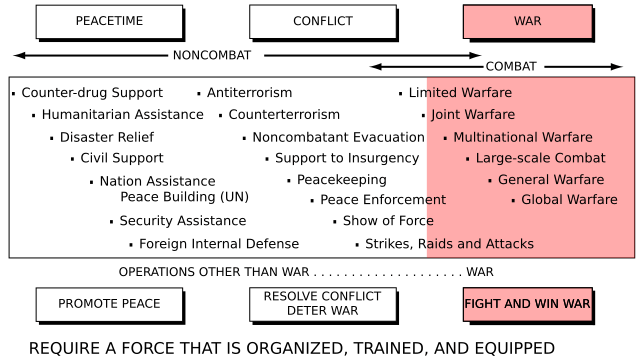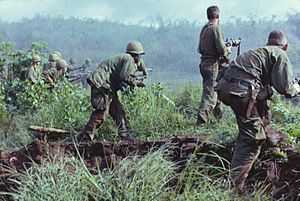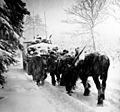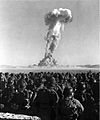United States Army facts for kids
Quick facts for kids United States Army |
|
|---|---|
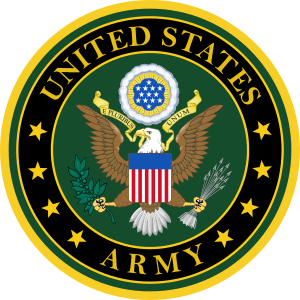 Military service mark of the United States Army 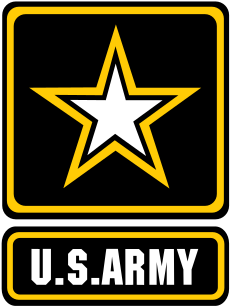 Army Star logo |
|
| Founded | 14 June 1775 (248 years, 10 months ago) |
| Country | |
| Type | Army |
| Role | Prompt and sustained land combat Combined arms operations
Set and sustain the theater for the joint force Integrate national, multinational, and joint power on land |
| Size | 485,000 Regular Army personnel (2021) 336,000 Army National Guard personnel (2021) 189,500 Army Reserve personnel (2021) 1,005,725 total uniformed personnel 252,747 civilian personnel (30 September 2020) 1,258,472 total 4,406 crewed aircraft |
| Part of | United States Armed Forces Department of the Army |
| Headquarters | The Pentagon Arlington County, Virginia, U.S. |
| Motto(s) | "This We'll Defend" |
| Colors | Black, gold and white |
| March | "The Army Goes Rolling Along" |
| Mascot(s) | Army Mules |
| Anniversaries | Army Birthday: 14 June |
| Equipment | List of U.S. Army equipment |
| Commanders | |
| Commander-in-Chief | |
| Secretary of Defense | |
| Secretary of the Army | |
| Chief of Staff | |
| Vice Chief of Staff | |
| Sergeant Major of the Army | |
| Insignia | |
| Flag | 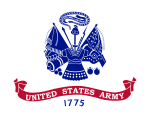 |
| Field flag | 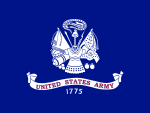 |
The United States Army is the main branch of the United States Armed Forces responsible for land-based military operations. It is the largest and oldest established branch of the U.S. military, and is one of seven U.S. uniformed services. The modern Army has its roots in the Continental Army which was formed on 14 June 1775, before the establishment of the United States, to meet the demands of the American Revolutionary War. The Congress of the Confederation officially created the United States Army on 3 June 1784 after the end of the revolutionary war to replace the disbanded Continental Army. The Army considers itself to be descended from the Continental Army and thus dates its inception from the origins of that force.
The primary mission of the Army is to "provide necessary forces and capabilities ... in support of the National Security and Defense Strategies." The Army is a military service within the Department of the Army, one of the three military departments of the Department of Defense. The Army is headed by the Secretary of the Army, and the highest ranking military officer in the department is the Chief of Staff of the Army.
It is the largest military branch, and in the fiscal year 2020, the projected end strength for the Regular Army (USA) was 480,893 soldiers; the Army National Guard (ARNG) had 336,129 soldiers and the U.S. Army Reserve (USAR) had 188,703 soldiers; the combined-component strength of the U.S. Army was 1,005,725 soldiers. As a branch of the armed forces, the mission of the U.S. Army is "to fight and win our Nation's wars, by providing prompt, sustained land dominance, across the full range of military operations and the spectrum of conflict, in support of combatant commanders". The branch participates in conflicts worldwide and is the major ground-based offensive and defensive force of the United States.
Contents
Mission
The United States Army serves as the land-based branch of the U.S. military. The purpose of the Army as:
- preserving the peace and security, and providing for the defense, of the United States, the Commonwealths and possessions, and any areas occupied by the United States
- supporting the national policies
- implementing the national objectives
- overcoming any nations responsible for aggressive acts that imperil the peace and security of the United States
Values
In the mid to late 1990s, the Army officially adopted what have come to be known as "The 7 Army Core Values." The Army began to teach these values as basic warrior traits. The seven Army Core Values are as follows:
- Loyalty – Bear true faith and allegiance to the U.S. Constitution, the Army, your unit, and fellow Soldiers.
- Duty – Fulfill your obligations.
- Respect – Treat others as they should be treated.
- Selfless Service – Put the welfare of the nation, the Army, and your subordinates before your own.
- Honor – Live the Army Values.
- Integrity – Do what's right, both legally and morally.
- Personal Courage – Face fear, danger, or adversity, both physical and moral.
The values were arranged to form the acronym LDRSHIP (leadership).
The Infantryman's Creed
I am the Infantry.
I am my country's strength in war. Her deterrent in peace. I am the heart of the fight -- wherever, whenever. I carry America's faith and honor against her enemies. Never will I fail my country's trust. Always I fight on -- through the foe to the objective, to triumph over all. If necessary, I fight to my death. By my steadfast courage, I have won two hundred years of freedom. I yield not -- to weakness, to hunger, to cowardice, to fatigue, to superior odds, for I am mentally tough, physically strong, and morally straight. I forsake not -- my country, my mission, my comrades, my sacred duty. I am relentless. I am always there, now and forever. I AM THE INFANTRY!
FOLLOW ME!
History
Origins
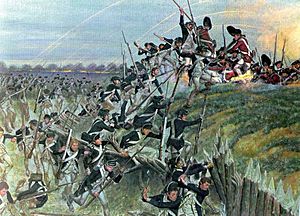
The Continental Army was created on 14 June 1775 by the Continental Congress as a unified army for the states to fight Great Britain, with George Washington appointed as its commander. The Army was initially led by men who had served in the British Army or colonial militias and who brought much of British military heritage with them. As the Revolutionary war progressed, French aid, resources, and military thinking influenced the new army, while Prussian assistance and instructors, such as Friedrich Wilhelm von Steuben, had a strong influence.
George Washington used the Fabian strategy and used hit-and-run tactics, hitting where the enemy was weakest, to wear down the British forces and their Hessian mercenary allies. Washington led victories against the British at Trenton and Princeton, and then turned south. With a decisive victory at Yorktown, and the help of the French, the Spanish and the Dutch, the Continental Army prevailed against the British, and with the Treaty of Paris, the independence of the United States was acknowledged.
After the war, though, the Continental Army was quickly disbanded as part of the American distrust of standing armies, and irregular state militias became the new nation's sole ground army, with the exception of a regiment to guard the Western Frontier and one battery of artillery guarding West Point's arsenal. However, because of continuing conflict with Native Americans, it was soon realized that it was necessary to field a trained standing army. The first of these, the Legion of the United States, was established in 1791 and disbanded in 1796.
19th century
The War of 1812, the second and last American war against Britain, was less successful than the Revolution had been. An invasion of Canada failed, and U.S. troops were unable to stop the British from burning the new capital of Washington, D.C.. However, the Regular Army, under Generals Winfield Scott and Jacob Brown, proved they were professional and capable of defeating a British army in the Niagara campaign of 1814. Two weeks after a treaty was signed, though, Andrew Jackson defeated the British invasion of New Orleans. However this had little effect; as per the treaty both sides returned to the status quo.
Between 1815 and 1860, a spirit of Manifest Destiny was common in the U.S., and as settlers moved west the U.S. Army engaged in a long series of skirmishes and battles with Native Americans that the settlers uprooted. The U.S. Army also fought and won the Mexican–American War (1846–1848), which was a defining event for both countries. The U.S. victory resulted in acquisition of territory that eventually became all or parts of the states of California, Nevada, Utah, Colorado, Arizona, Wyoming and New Mexico.
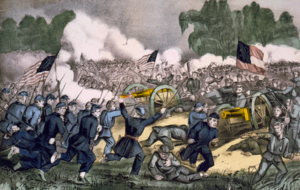
The Civil War was the most costly war for the U.S. in terms of casualties. After most states in the South seceded to form the Confederate States of America, CSA troops opened fire on the Union-held Fort Sumter in Charleston, South Carolina, starting the war. For the first two years Confederate forces solidly defeated the U.S. Army, but after the decisive battles of Gettysburg in the east and Vicksburg in the west, combined with superior industrial might and numbers, Union troops fought a brutal campaign through Confederate territory and the war ended with a Confederate surrender at Appomatox Courthouse in April 1865. The war remains the deadliest conflict in American history, resulting in the deaths of 620,000 soldiers. Based on 1860 census figures, 8% of all white males aged 13 to 43 died in the war, including 6% in the North and 18% in the South.
Following the Civil War, the U.S. Army fought a long battle with Native Americans, who resisted U.S. expansion into the center of the continent. By the 1890s the U.S. saw itself as a potential international player. U.S. victories in the Spanish-American War and the controversial and less well known Philippine-American War, as well as U.S. intervention in Latin America and the Boxer Rebellion, gained America more land and power.
20th century
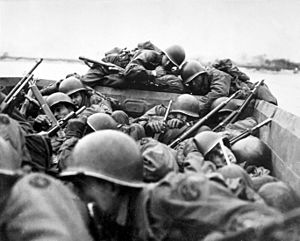
Starting in 1910, the Army began acquiring fixed-wing aircraft. In 1910, Mexico was having a civil war, peasant rebels fighting government soldiers. The Army was deployed to American towns near the border to ensure safety to lives and property. In 1916, Pancho Villa, a major rebel leader, attacked Columbus, New Mexico, prompting a U.S. intervention in Mexico until February 7, 1917. They fought the rebels and the Mexican federal troops until 1918. The United States joined World War I in 1917 on the side of Britain, France, Russia, and other allies. U.S. troops were sent to the front and were involved in the push that finally broke through the German lines. With the armistice in November 1918, the Army once again decreased its forces.
The U.S. joined World War II after the Japanese attack on Pearl Harbor. On the European front, U.S. Army troops formed a significant portion of the forces that captured North Africa and Sicily. On D-Day and in the subsequent liberation of Europe and defeat of Nazi Germany, millions of U.S. Army troops played a central role. In the Pacific, Army soldiers participated alongside U.S. Marines in capturing the Pacific Islands from Japanese control. Following the Axis surrenders in May (Germany) and August (Japan) of 1945, Army troops were deployed to Japan and Germany to occupy the two defeated nations. Two years after World War II, the Army Air Forces separated from the Army to become the United States Air Force in September 1947 after decades of attempting to separate. Also, in 1948 the Army was desegregated.
However, the end of World War II set the stage for the East-West confrontation known as the Cold War. With the outbreak of the Korean War, concerns over the defense of Western Europe rose. Two corps, V and VII, were reactivated under Seventh United States Army in 1950 and American strength in Europe rose from one division to four. Hundreds of thousands of U.S. troops remained stationed in West Germany, with others in Belgium, the Netherlands and the United Kingdom, until the 1990s in anticipation of a possible Soviet attack.
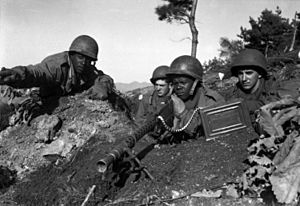
During the Cold War, American troops and their allies fought Communist forces in Korea and Vietnam. The Korean War began in 1950, when the Soviets walked out of a U.N. Security meeting, removing their possible veto. Under a United Nations umbrella, hundreds of thousands of U.S. troops fought to prevent the takeover of South Korea by North Korea, and later, to invade the northern nation. After repeated advances and retreats by both sides, and the PRC People's Volunteer Army's entry into the war, the Korean Armistice Agreement returned the peninsula to the status quo in 1953.
The Vietnam War is often regarded as a low point in the Army's record due to the use of drafted personnel, the unpopularity of the war with the American public, and frustrating restrictions placed on the Army by US political leaders. While American forces had been stationed in the Republic of Vietnam since 1959, in intelligence & advising/training roles, they did not deploy in large numbers until 1965, after the Gulf of Tonkin Incident. American forces effectively established and maintained control of the "traditional" battlefield, however they struggled to counter the guerrilla hit and run tactics of the communist Viet Cong and the North Vietnamese Army. On a tactical level, American soldiers (and the US military as a whole) did not lose a sizable battle.
The Total Force Policy was adopted by Chief of Staff of the Army General Creighton Abrams in the aftermath of the Vietnam War and involves treating the three components of the Army – the Regular Army, the Army National Guard and the Army Reserve as a single force. Believing that no U.S. president should be able to take the United States (and more specifically the US Army) to war without the support of the American people, General Abrams intertwined the structure of the three components of the Army in such a way as to make extended operations impossible, without the involvement of both the Army National Guard and the Army Reserve.
The 1980s was mostly a decade of reorganization. The Army converted to an all-volunteer force with greater emphasis on training and technology. The Goldwater-Nichols Act of 1986 created Unified Combatant Commands bringing the Army together with the other four military under unified, geographically organized command structures. The Army also played a role in the invasions of Grenada in 1983 (Operation Urgent Fury) and Panama in 1989 (Operation Just Cause).
By 1989 Germany was nearing reunification and the Cold War was coming to a close. The Army leadership reacted by starting to plan for a reduction in strength. By November 1989 Pentagon briefers were laying out plans to reduce Army endstrength by 23%, from 750,000 to 580,000. A number of incentives such as early retirement were used. In 1990 Iraq invaded its smaller neighbor, Kuwait, and U.S. land forces, quickly deployed to assure the protection of Saudi Arabia. In January 1991 Operation Desert Storm commenced, a U.S.-led coalition which deployed over 500,000 troops, the bulk of them from U.S. Army formations, to drive out Iraqi forces. The campaign ended in total victory for the Army, as Western coalition forces routed the Iraqi Army, organized along Soviet lines, in just one hundred hours.
After Desert Storm, the Army did not see major combat operations for the remainder of the 1990s but did participate in a number of peacekeeping activities. In 1990 the Department of Defense issued guidance for "rebalancing" after a review of the Total Force Policy, but in 2004, Air War College scholars concluded the guidance would reverse the Total Force Policy which is an "essential ingredient to the successful application of military force."
21st century
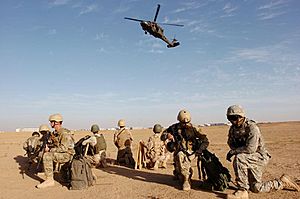
After the September 11 attacks, and as part of the Global War on Terror, U.S. and NATO combined arms (i.e. Army, Navy, Air Force, Marine, Special Operations) forces invaded Afghanistan in 2001, displacing the Taliban government.
The Army led the combined U.S. and allied Invasion of Afghanistan in 2001, and Iraq in 2003. In the following years the mission changed from conflict between regular militaries to counterinsurgency, with large numbers of terrorist attacks resulting in the deaths of more than 4,000 U.S service members (as of March 2008) and injuries to thousands more. The lack of stability in the theater of operations has led to longer deployments for Regular Army as well as Reserve and Guard troops.
Until 2009, the army's chief modernization plan, its most ambitious since World War II, was the Future Combat Systems program. In 2009, many systems were canceled, and the remaining were swept into the BCT modernization program. By 2017, the Brigade Modernization project was completed and its headquarters, the Brigade Modernization Command, was renamed the Joint Modernization Command, or JMC. In response to Budget sequestration in 2013, Army plans were to shrink to 1940 levels, although actual Active-Army end-strengths were projected to fall to some 450,000 troops by the end of FY2017. From 2016 to 2017, the Army retired hundreds of OH-58 Kiowa Warrior observation helicopters, while retaining its Apache gunships. The 2015 expenditure for Army research, development and acquisition changed from $32 billion projected in 2012 for FY15 to $21 billion for FY15 expected in 2014.
Equipment
The chief of staff of the Army has identified six modernization priorities, in order: artillery, ground vehicles, aircraft, network, air/missile defense, and soldier lethality.
Weapons
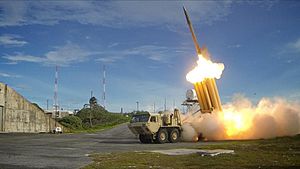
Individual weapons
The army employs various individual weapons to provide light firepower at short ranges. The most common weapon type used by the army is the M4 carbine, a compact variant of the M16 rifle, along with the 7.62×51mm variant of the FN SCAR for Army Rangers. The primary sidearm in the U.S. Army is the 9 mm M9 pistol; the M11 pistol is also used. Both handguns are to be replaced by the M17 through the Modular Handgun System program. Soldiers are also equipped with various hand grenades, such as the M67 fragmentation grenade and M18 smoke grenade.
Many units are supplemented with a variety of specialized weapons, including the M249 SAW (Squad Automatic Weapon), to provide suppressive fire at the squad level. Indirect fire is provided by the M320 grenade launcher. The M1014 Joint Service Combat Shotgun or the Mossberg 590 Shotgun are used for door breaching and close-quarters combat. The M14EBR is used by designated marksmen. Snipers use the M107 Long Range Sniper Rifle, the M2010 Enhanced Sniper Rifle and the M110 Semi-Automatic Sniper Rifle.
Crew-served weapons
The army employs various crew-served weapons to provide heavy firepower at ranges exceeding that of individual weapons.
The M240 is the U.S. Army's standard Medium Machine Gun. The M2 heavy machine gun is generally used as a vehicle-mounted machine gun. In the same way, the 40 mm MK 19 grenade machine gun is mainly used by motorized units.
The U.S. Army uses three types of mortar for indirect fire support when heavier artillery may not be appropriate or available. The smallest of these is the 60 mm M224, normally assigned at the infantry company level. At the next higher echelon, infantry battalions are typically supported by a section of 81 mm M252 mortars. The largest mortar in the army's inventory is the 120 mm M120/M121, usually employed by mechanized units.
Fire support for light infantry units is provided by towed howitzers, including the 105 mm M119A1 and the 155 mm M777.
The U.S. Army utilizes a variety of direct-fire rockets and missiles to provide infantry with an Anti-Armor Capability. The AT4 is an unguided projectile that can destroy armor and bunkers at ranges up to 500 meters. The FIM-92 Stinger is a shoulder-launched, heat seeking anti-aircraft missile. The FGM-148 Javelin and BGM-71 TOW are anti-tank guided missiles.
Vehicles
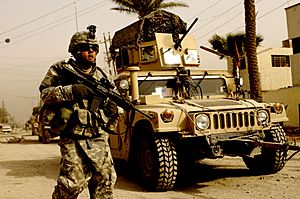
U.S. Army doctrine puts a premium on mechanized warfare. It fields the highest vehicle-to-soldier ratio in the world as of 2009. The army's most common vehicle is the High Mobility Multipurpose Wheeled Vehicle (HMMWV), commonly called the Humvee, which is capable of serving as a cargo/troop carrier, weapons platform and ambulance, among many other roles. While they operate a wide variety of combat support vehicles, one of the most common types centers on the family of HEMTT vehicles. The M1A2 Abrams is the army's main battle tank, while the M2A3 Bradley is the standard infantry fighting vehicle. Other vehicles include the Stryker, the M113 armored personnel carrier and multiple types of Mine Resistant Ambush Protected (MRAP) vehicles.

The U.S. Army's principal artillery weapons are the M109A6 Paladin self-propelled howitzer and the M270 Multiple Launch Rocket System (MLRS), both mounted on tracked platforms and assigned to heavy mechanized units.
While the United States Army Aviation Branch operates a few fixed-wing aircraft, it mainly operates several types of rotary-wing aircraft. These include the AH-64 Apache attack helicopter, the UH-60 Black Hawk utility tactical transport helicopter and the CH-47 Chinook heavy-lift transport helicopter. Restructuring plans call for reduction of 750 aircraft and from 7 to 4 types.
Under the Johnson-McConnell agreement of 1966, the Army agreed to limit its fixed-wing aviation role to administrative mission support (light unarmed aircraft which cannot operate from forward positions). For UAVs, the Army is deploying at least one company of drone MQ-1C Gray Eagles to each Active Army division.
Uniforms
The Army Combat Uniform (ACU) currently features a camouflage pattern known as Operational Camouflage Pattern (OCP); OCP replaced a pixel-based pattern known as Universal Camouflage Pattern (UCP) in 2019.
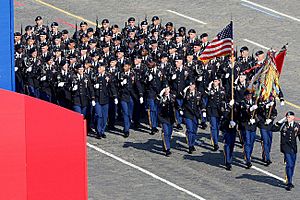
On 11 November 2018, the Army announced a new version of 'Army Greens' based on uniforms worn during World War II will become the standard garrison service uniform. The blue Army Service Uniform will remain as the dress uniform. The Army Greens are projected to be first fielded in summer of 2020.
Berets
The beret flash of enlisted personnel displays their distinctive unit insignia (shown above). The U.S. Army's black beret is no longer worn with the ACU for garrison duty, having been permanently replaced with the patrol cap. After years of complaints that it was not suited well for most work conditions, Army chief of staff General Martin Dempsey eliminated it for wear with the ACU in June 2011. Soldiers who are currently in a unit in jump status still wear berets, whether the wearer is parachute-qualified or not (maroon beret), while members of Security Force Assistance Brigades (SFABs) wear brown berets. Members of the 75th Ranger Regiment and the Airborne and Ranger Training Brigade (tan beret) and Special Forces (rifle green beret) may wear it with the Army Service Uniform for non-ceremonial functions. Unit commanders may still direct the wear of patrol caps in these units in training environments or motor pools.
Tents
The Army has relied heavily on tents to provide the various facilities needed while on deployment. The most common tent uses for the military are as temporary barracks (sleeping quarters), DFAC buildings (dining facilities), forward operating bases (FOBs), after action review (AAR), tactical operations center (TOC), morale, welfare and recreation (MWR) facilities, as well as security checkpoints. Furthermore, most of these tents are set up and operated through the support of Natick Soldier Systems Center. Each FPE contains billeting, latrines, showers, laundry and kitchen facilities for 50–150 Soldiers, and is stored in Army Prepositioned Stocks 1, 2, 4 and 5. This provisioning allows combatant commanders to position soldiers as required in their Area of Responsibility, within 24 to 48 hours.
The U.S. Army is beginning to use a more modern tent called the deployable rapid assembly shelter (DRASH). In 2008, DRASH became part of the Army's Standard Integrated Command Post System.
Related pages
- United States National Guard
- United States Army Reserve
- United States Army Center of Military History
Images for kids
-
U.S. Army soldiers look upon an atomic bomb test of Operation Buster-Jangle at the Nevada Test Site during the Korean War
-
U.S. Army soldiers prepare to take La Comandancia in the El Chorrillo neighborhood of Panama City during the United States invasion of Panama
-
Army Rangers from the 1st Ranger Battalion conduct a MOUT exercise at Fort Bragg, North Carolina.
-
U.S. soldiers from the 6th Infantry Regiment taking up positions on a street corner during a foot patrol in Ramadi, Iraq
-
Rangers practice fast roping techniques from an MH-47 during an exercise at Fort Bragg
-
Lockheed Martin Terminal High Altitude Area Defense (THAAD) system used by the army for ballistic missile protection
-
American troops of the 28th Infantry Division march down the Champs-Élysées, in the victory parade following the Liberation of Paris.
See also
 In Spanish: Ejército de los Estados Unidos para niños
In Spanish: Ejército de los Estados Unidos para niños


